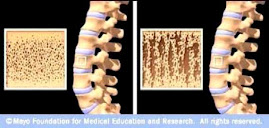The purposes of a retrospective study
published in the journal, “Spine” were to investigate the validity of bone
mineral density measurements with DEXA in patients with adult lumbar scoliosis
and to investigate the association between osteoporosis and adult lumbar
scoliosis. Osteoporosis and lumbar degenerative scoliosis are phenomena
encountered with increased frequency in aging, often concurrently. Scoliotic
patients demonstrated increased spinal bone mineral density (BMD) measurements
compared with nonscoliotic patients, resulting in discrepancies between hip and
spine BMD values. This discrepancy correlated with aging and curve magnitude
(up to 30% for curves of 43°). Scoliotic patients demonstrated significantly
lower hip BMD values than nonscoliotic. Curve magnitude did not correlate with
severity of osteoporosis.
Spinal BMD values are less valuable
for monitoring osteoporosis than hip values in scoliotic patients; an
increasing discrepancy with age was noted. Scoliotic patients exhibited
discordantly high spinal BMD values, despite significant hip osteoporosis. The
discrepancy correlated with aging and curve magnitude. Scoliosis was common
among the osteoporotic population (9.47%). Lumbar scoliosis is a useful
clinical marker for osteoporosis, irrespective of scoliosis history and
magnitude. Viable alternatives for osteoporosis evaluation of adult patients
with lumbar scoliosis are hip DEXA values, in conjunction with other BMD
measurements.



No comments:
Post a Comment